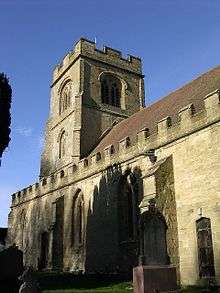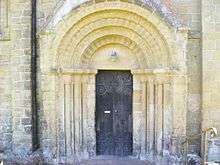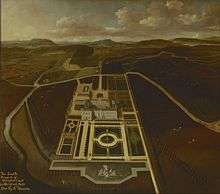Humphrey Coningsby (judge)
| Sir Humphrey Coningsby | |
|---|---|
| Born | Rock, Worcestershire, England |
| Died |
2 June 1535 England |
| Occupation | Lawyer, judge |
| Parent(s) | Thomas Coningsby, Catherine Waldiffe |
Sir Humphrey Coningsby, (d. 2 June 1535), was an English lawyer, a senior judge as a Justice of the King's Bench and a major landholder.[1][2]

Origins
Humphrey Coningsby was born shortly before 1460, the son of Thomas Coningsby and his wife Catherine Waldiffe, at the village of Rock in Worcestershire where his father held the manor of Bower, which had been in the family since at least 1351.[3]
Career
Entering the law, he was practising as an attorney in the Court of Common Pleas by 1474 and in 1476 acted as Deputy to the Sheriff of Worcestershire. In the 1480s he was the third Prothonotary, the Clerk of Assize on the Western Circuit and became a Bencher of the Inner Temple. Chosen a justice of the peace for Hertfordshire in 1493, he was created a Serjeant-at-Law in 1495, with clients including Queen Elizabeth and the Duke of Buckingham. In 1504 he was added to the commission of the peace for Worcestershire and was promoted to King's Serjeant in 1505.[3] On 21 May 1509, he became a Justice of the King's Bench, being knighted by King Henry VIII that year, and held his position until 28 November 1533.[4]
Landholdings
In parallel with his legal work, he actively acquired country estates. About 1485 he was executor to Ralph Penne,[3] owner of Penne's Place in Aldenham, Hertfordshire, which he bought. It remained in the family until 1651.[5] From Penne he also acquired the manor of Pigott's in Aldenham.[5] In June 1488, jointly with his first wife Isabel, he bought from William Berkeley, then Earl of Nottingham, the manor of North Piddle in Worcestershire,[6] which descended in the family until 1654. At the same time he acquired the manor of Stottesdon in Shropshire.[7]
Between 1496 and 1514 he bought more manors or portions of a manor in Titburst, part of Aldenham, from the co-heiresses but his grandson sold them in 1548.[5] In 1506 he acquired the manor of Orleton in the parish of Eastham in Worcestershire, which his descendants sold in 1658.[8]

By 1509 he had inherited his father's estate at Rock, where he built the south chapel, south aisle and west tower of the village church, in which a window once portrayed him in a scarlet gown with his family. In 1510 he founded the chantry of our Blessed Lady and St George in the new south chapel and endowed it with lands for the support of one priest who was to say mass and run a free grammar school, which was set up in 1513.[3] To his inheritance in the parish he added lands by acquiring the manor of Cheney Moor in 1528, which remained in the family until 1657.[9]

Around 1510 he acquired the estate of Hampton Court at Hope under Dinmore in Herefordshire, which went to his grandson Humphrey and remained in the family for nearly 300 years.[9]
Death and memorials
An inscription in Rock church, since lost, recorded: 'Here lieth Thomas Coningsby, esq., who deceased A.D. 1498, father to Sir Humphrey Coningsby, knt. and one of the justices of the king's bench, who built this isle and steeple of the church, A.D. 1510, at his own charges. He died at Aldnam, in the county of Hertford, …. and is intombed in that church.'[9]
Dying on 2 June 1535, his will was proved on 26 November 1535. In it, he left rents from lands he owned in Aldenham for funding a priest to say mass for his soul in the chapel of Our Lady in the parish church for 21 years from the date of his death. He also provided for an extension of the chapel to the line of the east wall of the chancel, but this was never carried out. At Copthorne Hill in Aldenham, he had earlier founded the chapel of St Mary the Virgin and St George the Martyr, which was licensed for eucharist and baptisms in 1520. As a chantry, this chapel was destroyed under the Act of 1547.[5]

In his native Rock, his will left directions that the tabernacle of Our Lady he had recently had erected in the south aisle should be painted and gilded together with the image of St George, and that the image of St Margaret in the Lady Chapel should be restored.[9]
Marriages and family
His first marriage, in the 1480s, was to Isabel, daughter of Thomas Fereby of St Paul's Cray and related to Ralph Penne. About 1499 he married Alice, daughter and heiress of Sir John Francis and widow of both John Worsley and William Staveley, but she died in 1500. Then in 1504 he married Anne, daughter and heiress of Sir Christopher Moresby of Scaleby and widow of James Pickering. She died before him in 1523.[3] His sons, all from his first marriage, were:
- Thomas, who married Cecily Salway, was father of Humphrey Coningsby and grandfather of Sir Thomas Coningsby.[3]
- William, also a Justice of the King's Bench.[3]
- John, married Elizabeth Frowick and was the father of Sir Henry Coningsby.[3]
His daughters were;
- Elizabeth, married first Richard Berkeley and was the mother of Sir John Berkeley, who inherited the estate of Stoke Gifford, as well as of Sir Maurice Berkeley. Her second husband was Sir John FitzJames, Lord Chief Justice of the King's Bench.[3]
- Amphelisia, married John Tyndall.
- Margaret, married Christopher Hilliard, who died at the siege of Thérouanne in 1537 and was grandfather of Sir Christopher Hilliard.
- Jane, married George Raleigh.
References
- ↑ Collins, Arthur; Brydges, Sir Egerton (1812), Collins's Peerage of England, Vol. 10, F. C. and J. Rivington, p. 411
- ↑ Works of the Camden Society, Volume 39, Camden Society, 1847, p. 5
- 1 2 3 4 5 6 7 8 9 Baker, J.H. (Jan 2008), Oxford Dictionary of National Biography, Oxford: Oxford University Press, retrieved 24 January 2016 Subscription or UK public library membership required
- ↑ Rogers, Pat (2011), The Life and Times of Thomas, Lord Coningsby: The Whig Hangman and his Victims, Continuum International Publishing Group, p. 18
- 1 2 3 4 Page, William, ed. (1908), "Parishes: Aldenham", A History of the County of Hertford, 2, London, pp. 149–161, retrieved 20 January 2016
- ↑ Page, William and Willis-Bund, J W, eds. (1924), "Parishes: North Piddle", A History of the County of Worcester, 4, London, pp. 177–180, retrieved 20 January 2016
- ↑ Berkeley Castle Muniments BCM/D/5/74 cited at http://discovery.nationalarchives.gov.uk/ Accessed 20 January 2016
- ↑ Page, William and Willis-Bund, J W, eds. (1924), "Parishes: Eastham", A History of the County of Worcester, 4, London, pp. 265–272, retrieved 22 January 2016
- 1 2 3 4 Page, William; Willis-Bund, J W, eds. (1924), "Parishes: Rock or Aka", A History of the County of Worcester, 4, London, pp. 319–328, retrieved 24 January 2016